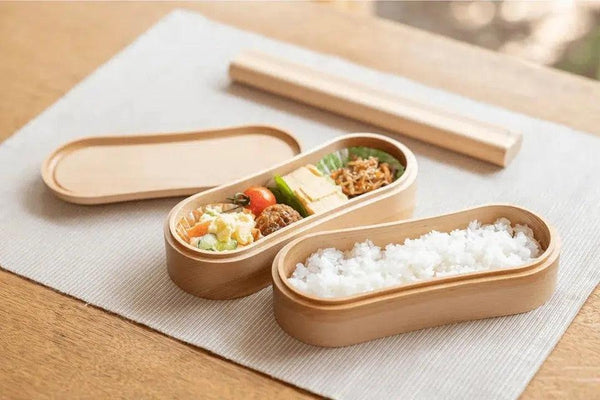All About The Bento Box: Everything You Should Know About This Japanese Lunch Box

Jump to:
If you watch Japanese dramas (dorama), you’ve no doubt seen a mother preparing a bento box for her child. Or, maybe you’ve seen a girl making a bento for a boy she has a crush on. Bento boxes (obento or just bento for short) are usually made for lunch in Japan, but they can also be a way to express love and care toward someone.
In daily life, the bento box is a convenient — and kind of kawaii (cute) — way to enjoy a well-balanced meal. This article will talk about bento history, what’s in a bento box and even their rising popularity outside Japan.
Note: This article will use bento as the plural and singular form of the word. This is how it’s used in Japanese (so, no “bentos” will be seen in this article - but you’re not incorrect if you say it with an “s”).
What Is A Bento Box?

A bento box is a container (usually box-shaped, but there are also rounded ones) with a variety of small-portioned foods inside (although it is sometimes just one food — like sandwiches). It’s often the lunch box people take to work or school, or something people pick up at the station to eat on their train ride (ekiben). Bento traditionally consist of rice, meat or fish, vegetables, and sometimes pickled or preserved items, but they can contain pretty much anything you like. Creativity is welcome!
The History Of The Bento Box
The bento box has a history that goes back centuries. Japan’s Ministry of Foreign Affairs says that people were preparing meals to-go way back in the 5th century. These meals weren’t exactly the same as the bento of today, though. During this time, the concept of packing meals for easy transportation was a way for warriors, hunters or travelers to eat meals on their journeys. These early bento box containers were made of wood or bamboo and had — much like today — compartments to separate different food items.
It was during the Edo period (1603-1867) that the bento box got really popular. Some say the word “bento” itself came from a famous Japanese leader at the time, Oda Nobunaga (he would distribute food to the people from his castle that he called bento — guess the name stuck).
According to the US Embassy of Japan, “The bento became an essential meal for outings. In particular, the makunouchi bento, or ‘between-scenes bento,’” When people went to see a play, the makunouchi bento was literally eaten during the breaks between scenes. The term is still used for this particular type of bento box, and it remains a popular bento today (not just for watching plays). It was also around this time that bento boxes became more refined. Some boxes were decorated and made from special materials like lacquered wood.
One notable historical moment for the bento box was when the ekiben was introduced in the 1800s. Ekiben refers to bento boxes sold specifically at train stations, made for travelers who want a convenient meal option for their train rides. NHK said, “The contents of the small ekiben lunch box reflect a place and a time, and are filled with the flavors of that region, the emotions of the person who made it, and the memories of a journey.”
As time went on, bento boxes became more accessible and available across Japan. The rise of convenience stores and supermarkets made pre-packaged bento available, giving people a quick and convenient option for lunch. And — as you know, because you’re reading this article — the popularity of bento spread to other countries, as well. They’re just so darned cute and tasty that everyone wanted to get in on the bento craze.
What Goes Inside A Bento Box

A bento box is usually pretty balanced. It has various kinds of food that are carefully arranged in separate compartments (sometimes adorably so). The specific contents of a bento box can vary based on who made it and the region you’re in. Ekiben that you pick up at a train station, for example, often have local foods in them to showcase what’s available in the area. Generally speaking, though, there are some staples that you’ll often find in a bento. Here are some of the common ones.
- Starches - Rice is almost always in a bento box, and it’s sometimes seasoned with furikake (a delicious seasoning mix). You can also find bento with noodles or sandwiches, if you’re not in the mood for the ubiquitous rice.
- Meat - A bento box usually includes some kind of meat — like fish, chicken or beef. It can be prepared in many different styles. If you’re vegan or vegetarian (or just want a different option) you can find meat-free or tofu options, as well.
- Vegetables - All kinds of vegetables are used in bento. Common choices include carrots, daikon (white radish), tomatoes and more. The vegetables can be shaped and arranged to make the whole thing look super cute, too. By the way, the internet says nori (a type of seaweed) is technically a vegetable, and you will definitely find that in bento boxes.
- Various Mini-dishes - Bento may include “side dishes” like tamagoyaki (rolled omelet), gyoza (dumplings), tempura or small portions of noodle dishes like yakisoba (fried noodles) or udon (thick wheat noodles).
- Pickles - Japanese pickles, known as tsukemono, are commonly included in bento boxes. These pickles can be tangy, salty or slightly sweet. Yum!
- Fruits - Sometimes you’ll find bento with fresh fruits like melon, orange or grapes. These can also be shaped and arranged to make the bento really cute.
- Desserts - Some bento boxes include a small dessert, like a sweet mochi, wagashi (traditional Japanese dessert) or even a little cake!
Types Of Bento: Who’s “Ben?”

There are many different types of bento boxes in Japan, each with its own unique ingredients and style of presentation. You’ll probably notice that a lot of these types of bento end in "ben." Can you guess why? It’s not because Ben Franklin invented them. It’s short for "bento!" Anyway, here are some popular types of bento.
- Ekiben - This bento box is sold in train stations (quite popular on the Shinkansen) and often features foods from the local area. For example, if you buy an ekiben in Hokkaido, you might find one of their local specialties, ikameshi (stuffed squid), in your box. Definitely try an ekiben if you’re traveling by train — who knows what unique and delicious foods you might discover!
- Makunouchi Bento - It usually contains white rice sprinkled with black sesame seeds and is topped with umeboshi (pickled plums), but there are many variations that can include fish, seaweed and more.
- Hinomaruben - A bento that has a section of rice with a reddish umeboshi in the middle. It looks like the Japanese flag!
- Noriben - A combination of the words nori (a type of seaweed) and ben (again — short for “bento”), this is a simple bento made of rice and soy sauce. It sometimes has bonito flakes, but it’s always topped with nori.
- Kyaraben - This is short for "character bento" — it’s a type of bento decorated to look like cute characters (from anime or manga, for example).
- Frugalben - A more recent term — this is (perhaps obviously) a bento box that is not too expensive to make. The “Cheap Chick” talks about it on JustBento.
Bento Box Containers
Bento box containers are the “boxes” (although not always box-shaped) used to hold and store a bento meal. They are containers designed specifically for packing and transporting your bento. Where can you buy one? Great question! Take a look at some bento containers on Japanese Taste here. There’s also a great video that talks about different types of containers on the “You Need a Bento” YouTube channel.
Buying Bento: Where And How Much

You can buy bento all over Japan, and the price you pay will vary depending on where you buy it and what’s in it. Here are some popular spots to get bento — along with price ranges.
- Convenience Stores - Bento boxes sold at convenience stores (konbini) are quick and easy, fresh and (usually) tasty, but the quality isn’t as high as some other options listed here. The price for a basic bento ranges from around ¥300 to ¥1000 yen ($2-7 USD).
- Train Stations - Ekiben (train station bento) prices can range from a few hundred yen to several thousand yen ($3 to $30 USD). That’s a huge price range, but it really just depends on the size of the bento and the type of food inside.
- Supermarkets - Most supermarkets in Japan have a section dedicated to prepared foods, including bento. These bento are usually available in the deli or prepared foods section. Check out some supermarket bento purchases and taste-testing by YouTube channel, TabiEats.
- Bento Shops - These shops specialize in bento, so they probably have the best bento of them all! One place to find a bento shop (besides just searching on Google) is in a depachika (department store basement). Depachika are full of little food shops — including bento. Prices generally range from ¥800-1400 yen ($6-10 USD), but they can go much higher depending on the quality and size. Check out this video by Paolo from Tokyo to see what happens behind the counter in a local bento shop!
Bento Beyond Japan
Bento boxes have gotten really popular outside of Japan lately. Dare we say it’s become a craze? Many are not only buying bento, but they’re making it, too. DIY bento culture has become so popular that there’s even a YouTube community out there making videos about it. If you’re interested in making bento yourself, it’s a great time to start. There are so many cute containers, tools, and decorations you can use.
Expressing Love with Bento?

Maybe we don’t think about it often, but packed lunches can be a way of giving and receiving affection. The amount of work and care one puts into the creation and presentation of a lunch can really convey how much someone cares. In Japan, bento boxes are a meal — yes — but they can also convey a message. A really great example of this is the touching story by Japanese American, Kaki Okumura. She wrote about the bento her mom used to make her when she was growing up. But, it’s not only family love that a packed lunch or bento can show. You can also show romantic interest with a bento box. In fact, you can see this a lot in Japanese TV dramas.

0 comments